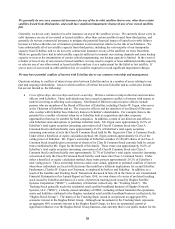Dish Network 2014 Annual Report Download - page 58
Download and view the complete annual report
Please find page 58 of the 2014 Dish Network annual report below. You can navigate through the pages in the report by either clicking on the pages listed below, or by using the keyword search tool below to find specific information within the annual report.48
48
From time to time a portion of our investment portfolio may be invested in securities that have limited liquidity
and may not be immediately accessible to support our financing needs, including investments in public
companies that are highly speculative and have experienced and continue to experience volatility.
From time to time a portion of our investment portfolio may be invested in strategic investments, and as a result, a
portion of our portfolio may have restricted liquidity. If the credit ratings of these securities deteriorate or there is a
lack of liquidity in the marketplace, we may be required to record impairment charges. Moreover, the uncertainty of
domestic and global financial markets can greatly affect the volatility and value of our marketable investment
securities. In addition, a portion of our investment portfolio may include strategic and financial investments in debt
and equity securities of public companies that are highly speculative and experience volatility. Typically, these
investments are concentrated in a small number of companies. The fair value of these investments can be
significantly impacted by the risk of adverse changes in securities markets generally, as well as risks related to the
performance of the companies whose securities we have invested in, risks associated with specific industries, and
other factors. These investments are subject to significant fluctuations in fair value due to the volatility of the
securities markets and of the underlying businesses. The concentration of these investments as a percentage of our
overall investment portfolio fluctuates from time to time based on, among other things, the size of our investment
portfolio and our ability to liquidate these investments. In addition, because our portfolio may be concentrated in a
limited number of companies, we may experience a significant loss if any of these companies, among other things,
defaults on its obligations, performs poorly, does not generate adequate cash flow to fund its operations, is unable to
obtain necessary financing on acceptable terms, or at all, or files for bankruptcy, or if the sectors in which these
companies operate experience a market downturn. To the extent we require access to funds, we may need to sell
these securities under unfavorable market conditions, record impairment charges and fall short of our financing
needs.
We have substantial debt outstanding and may incur additional debt.
As of December 31, 2014, our total debt, including the debt of our subsidiaries, was $14.464 billion. Our debt levels
could have significant consequences, including:
requiring us to devote a substantial portion of our cash to make interest and principal payments on our debt,
thereby reducing the amount of cash available for other purposes. As a result, we would have limited
financial and operating flexibility in responding to changing economic and competitive conditions;
limiting our ability to raise additional debt because it may be more difficult for us to obtain debt financing
on attractive terms; and
placing us at a disadvantage compared to our competitors that are less leveraged.
In addition, we may incur substantial additional debt in the future. The terms of the indentures relating to our senior
notes permit us to incur additional debt. If new debt is added to our current debt levels, the risks we now face could
intensify.
It may be difficult for a third-party to acquire us, even if doing so may be beneficial to our shareholders,
because of our ownership structure.
Certain provisions of our certificate of incorporation and bylaws may discourage, delay or prevent a change in
control of our company that a shareholder may consider favorable. These provisions include the following:
a capital structure with multiple classes of common stock: a Class A that entitles the holders to one vote
per share, a Class B that entitles the holders to ten votes per share, a Class C that entitles the holders to one
vote per share, except upon a change in control of our company in which case the holders of Class C are
entitled to ten votes per share;
a provision that authorizes the issuance of “blank check” preferred stock, which could be issued by our
Board of Directors to increase the number of outstanding shares and thwart a takeover attempt;
a provision limiting who may call special meetings of shareholders; and
























